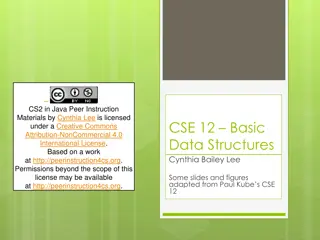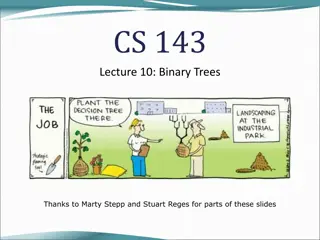Advanced Troubleshooting Guide for P2P Connectivity in ISP and Wide Networks
This troubleshooting guide is tailored for operators, network experts, and engineers dealing with Dahua P2P NAT traversal protocol issues. It covers different types of NAT, including Full Cone NAT, Restricted Cone NAT, Port Restricted Cone NAT, and Symmetric NAT, providing insights and solutions for
0 views • 17 slides
Exploring Trees Data Structures Using C - Second Edition
Learn about trees data structures in the context of programming using the C language. This comprehensive guide covers topics such as types of trees, tree creation, traversal, basic terminologies, and different tree structures like binary trees and binary search trees. Dive into the world of trees da
2 views • 54 slides
Understanding Strings in Python Programming
Strings in Python are sequences of characters with various operations like initialization, accessing, traversal, slicing, and mutability. Learn about basic concepts, such as string initialization using quotes, accessing individual characters, determining string length, traversing strings, slicing su
0 views • 20 slides
Understanding Directory Structures in Operating Systems
Directory structures play a crucial role in operating systems, organizing files, and supporting essential operations like file search, creation, deletion, listing, and traversal. This content explores single-level and two-level directory structures, addressing their benefits and limitations in manag
2 views • 23 slides
Understanding Binary Search Trees and Tree Traversal Methods
Explore the world of binary search trees with a focus on defining trees, modifying them, and different ways to print their contents. Delve into the concept of tree traversal methods such as pre-order, in-order, and post-order. Additionally, discover insights into searching algorithms for arrays of n
0 views • 14 slides
Binary Trees and Heap Implementation in Java
Explore the concepts of binary trees, heap implementation, and traversal techniques in Java through engaging peer instruction materials by Cynthia Lee. Learn about heap uniqueness, in-place heapsort, and generic binary trees. Test your knowledge with reading quizzes and analyze heap outcomes based o
0 views • 27 slides
Comprehensive Course Overview on Algorithm Analysis and Design
Explore a detailed syllabus covering mathematical foundations, complexity calculations, asymptotic analysis, dynamic programming, traversal techniques, and more. Dive into key concepts like recursion, divide and conquer, greedy algorithms, backtracking, and approximation algorithms. Gain insights in
1 views • 11 slides
Exploring Python Lists in Class XI Module-4 by Mrs. Sujata Pradhan
Exploring list structures, characteristics, and operations in Python. Covering topics such as mutability, basic list operations, indexing, slicing, concatenation, repetition, traversal, updation, and comparison. Detailed explanations on list methods like append, extend, insert, index, sort, count, r
0 views • 12 slides
Ligra: A Lightweight Graph Processing Framework for Shared Memory
Ligra is a lightweight graph processing framework developed by Julian Shun during his time at the Miller Institute, UC Berkeley. This framework, created in collaboration with Laxman Dhulipala and Guy Blelloch, is designed for shared memory systems to efficiently analyze large graphs. Key features in
0 views • 21 slides
Understanding Graph Data Structures and Algorithms by Ali Akbar Mohammadi
This content delves into the foundational concepts of graph data structures, covering topics such as graph traversal, transitive closure, minimum spanning trees, and more. Ali Akbar Mohammadi provides insight into the world of graphs, emphasizing the importance of vertices, edges, and the relationsh
0 views • 19 slides
Understanding Doubly Linked Lists in Data Structures
Doubly linked lists contain nodes with both forward and backward links, allowing traversal in both directions. The nodes can be inserted or deleted at the beginning, middle, or end, requiring updating of links accordingly. Additionally, a recursive method can be used to manipulate data in each node,
0 views • 17 slides
Understanding NHDPlus Training Series: PlusFlow Table and Tool Navigator
This content delves into understanding the format and content of the NHDPlus Training Series, specifically focusing on the PlusFlow Table and NHDPlusV2 Flow Table Navigator Tool. It explains the purpose of the tool, how it enables network traversal, and the key components of the PlusFlow Table. Addi
0 views • 21 slides
Understanding Graph Modeling and DFS Applications
Explore the world of graph modeling and DFS applications through lectures on graph vocabulary, edge classification in directed graphs, and the use of DFS to find cycles. Discover the significance of tree edges, back edges, forward edges, and cross edges in graph traversal. Learn how DFS can be utili
0 views • 32 slides
Understanding Binary Trees in Computer Science
Binary trees are a fundamental data structure in computer science with various applications. This content covers the basics of binary trees, including terminology, recursive definitions, node structures, and implementations in computer science. It touches on important concepts such as recursion, tre
0 views • 28 slides
Understanding Tree Data Structures in Computation
Explore the theory of computation trees, tree properties, and terminology including nodes, root, leaves, siblings, ancestors, descendants, and more. Learn about subtree representation, tree traversal methods, and the concept of binary trees in computing.
0 views • 10 slides
Graph Modeling in Data Structures and Algorithms
Exploring graph modeling in CSE 373, this lecture covers topics such as using BFS for finding shortest paths, limitations of BFS on weighted graphs, and the introduction of Dijkstra's algorithm for weighted graphs. It emphasizes the importance of considering edge weights in determining traversal ord
0 views • 29 slides
Understanding B-Trees: A Comprehensive Guide
B-Trees are a standard data structure for key-value stores, ensuring efficient CRUD operations and range queries. They store records structured in a balanced tree format, ideal for fast data retrieval. This guide explores different variants and examples of B-Trees, explaining their functionalities a
0 views • 73 slides
Dynamic Programming for Finding Paths of Length k in Graphs
Today's plan involves exploring dynamic programming techniques for finding paths of length k in graphs. The focus will be on solving the rainbow-k-path problem and utilizing DP algorithms to achieve efficient solutions. By constructing tables and utilizing key observations, we aim to find simple pat
0 views • 15 slides
Depth-First Search Exploration Techniques
Depth-First Search (DFS) is a graph traversal algorithm that explores all edges leaving a vertex before backtracking. It continues until all reachable vertices are discovered. This process involves classifying edges as tree, back, forward, or cross edges based on the relationship between vertices. D
0 views • 22 slides
Understanding Depth-First Search in Graph Algorithms
Delve into the world of graph algorithms and explore Depth-First Search (DFS) in both undirected and directed graphs. Learn about tree edges, back edges, forward edges, and cross edges, along with the terminology associated with DFS trees. Discover how to detect back edges and perform a depth-first
2 views • 22 slides
Understanding STD Containers and Iterators in C++ Programming
In C++ programming, STD containers and iterators play a crucial role in managing data structures and traversal methods efficiently. By utilizing these tools effectively, programmers can enhance the performance and reliability of their code. This involves working with various container types, such as
0 views • 33 slides




















